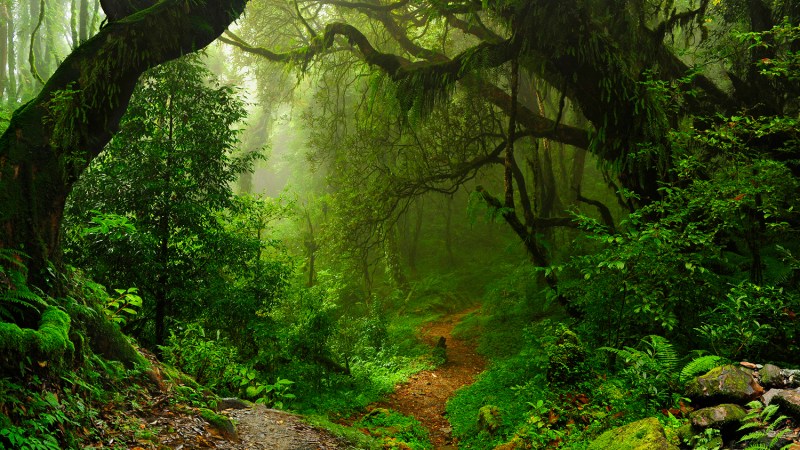I remember the first — and so far only, fingers crossed — leech I had to remove from myself. I had been walking on a wet and overgrown trail in a pair of sandals, and the little sucker latched onto my big toe. With nothing on hand to do the job properly and with no real knowledge of what I was doing, I just pulled the leech off and threw it back into the bushes. Big mistake. This was my first experience with a leech, and if I'd known then what I know now, it would have gone down very differently.
Leeches are notorious. They get a bad rep thanks to years of harrowing medical use, not to mention their place in plenty of horror films. Any animal renowned for sucking your blood isn't going to feature on your top-ten cutest pets list, but are leeches really that bad? Well, in short, they're not, but that doesn't mean you want to end up covered in them. But spend enough time outdoors, and they're among the many wild creatures you're likely to encounter. Here's what to do to avoid repeating my mistakes and how to remove a leech the right way.

Are leech bites dangerous?
Generally, no. Most leech bites result in a minor flesh wound and some bleeding. But so long as you have a first aid kit on hand to stem the flow of blood, you won't suffer any long-term effects. They can bleed a lot, though. In fact, because leeches release an anti-coagulant to prevent blood clotting and make it easier to feed, you can bleed for up to ten hours from a leech bite.
Unless you get hundreds of leeches on you all at once, you're not about to bleed out from leeches. And even the deepest of sleepers is going to notice hundreds of bites — sorry, scrapes — happening at the same time, despite the best efforts of the leeches and their anesthesia. No, in reality, leech bites are not dangerous, but the danger comes from improper removal. Unlike humans, the digestive system of a leech does not sterilize its gut, and a squeezed or startled leech can regurgitate the contents of its gut into the wound as they are removed.
Given that you don't know what these suckers have been feeding on before, you never know what they might be harboring, so proper removal is important to avoid infection, especially if you're deep into your backpacking trip.

How to avoid leech bites
As with all backcountry survival techniques, avoidance is better than a cure. Not getting bitten by a leech is always going to be a better option than knowing how to remove them safely. Remember that with leeches, a little like bears and other animals, you're going into its home, so you can't really blame it for being interested in you.
To avoid leeches, you basically want to limit their access to your skin where possible. Tucking your hiking pants into your long hiking socks and your shirt into your pants can reduce this, but a proper pair of anti-leech socks is the best way to go. These might look like oversized gators — or trousers fit for the circus — but they provide the best protection against these bloodsuckers. What's more, if you do have a leech climbing up your leg, you can usually spot it early and remove it.
You can create your own repellent if you don't have the proper gear by using Deet or insect repellant on your tucked-in clothing to deter them. Leeches also dislike tobacco, and you can create a tobacco spray by crushing the leaves in water and spraying it onto your body, though you might find this just as repellant as the leeches do. The best option is to check regularly for leeches and try to avoid going for a cooling dip in squalid-looking pools, no matter how warm you are.

How to remove a leech
So you've found a leech on you. Well, that sucks, but if you act quickly and remove it properly, you'll be just fine.
Step 1: Identify the anterior sucker/mouth of the leech, which is usually at the narrower end of the animal. Use a flat, blunt object — ideally a credit card or other similar tool though a fingernail can suffice — and slowly but firmly slide the edge between the sucker and the skin.
Step 2: Once the suction breaks and the leech's head detaches, grab the body with your fingers to dislodge the posterior sucker — or dig under it with your flat, broad implement — and then throw that thing as hard and far as you can! Or actually, just drop it back into the water gently — horrifying as they may be, leeches are just another one of earth's creatures, and they mean you no personal harm.
Step 3: Leeches usually only feed for half an hour or so, and, once full will generally drop off by themselves. If you have no other means of removal, you can always just let it feed — though perhaps not if there are loads of them.
Step 4: Once the leech is off, clean the bite with water and an antiseptic. Dry the area, then clean again —ideally with hydrogen peroxide, which can reduce the effects of the anticoagulant.

How not to remove a leech
People remove leeches in all sorts of ways, the most common being with a terrified swatting and/or grabbing before reason has set in. If you roughly yank a leech off your skin, you run the risk of causing it to vomit out potentially bacteria-filled blood, as mentioned before.
Other common but inadvisable leech removal techniques include burning it with a flame or with the embers of a cigar or cigarette or dumping salt or vinegar over the animal. These approaches will get the leech off, but they increase the risk of infection for you, and they're needlessly cruel to the animal.

Where can you encounter leeches?
Leeches have a surprisingly wide distribution, found across various locations around the globe. Here's a rundown of some areas where you might encounter these hungry suckers:
Rainforests: These lush, humid environments are prime real estate for leeches, especially in Southeast Asia, South America, and Africa. Think Amazon rainforest, Borneo, and the Congo Basin.
Wetlands: Swamps, marshes, and mangroves provide another ideal habitat for leeches, offering plenty of moisture and shade.
Islands: Tropical islands like Hawaii, Madagascar, and New Zealand also harbor various leech species.
Forests: Leeches love damp, shady woodlands, so be aware when hiking in temperate forests in North America, Europe, and East Asia.
Mountainous areas: Even at higher altitudes, leeches can thrive in damp environments like moss-covered rocks and streams.




